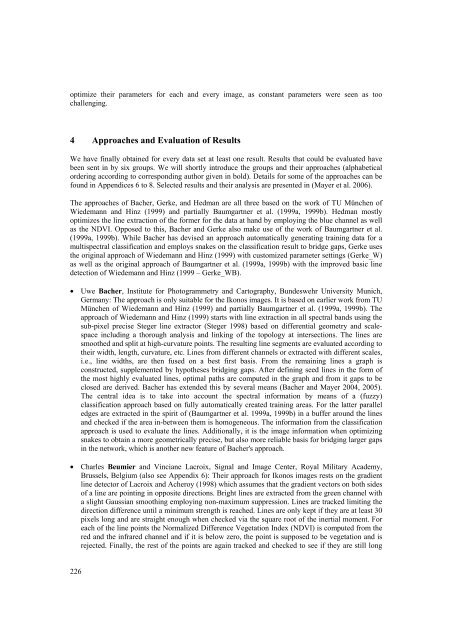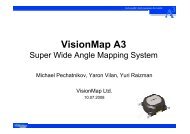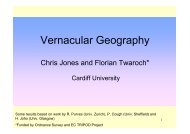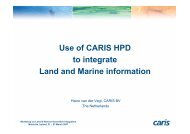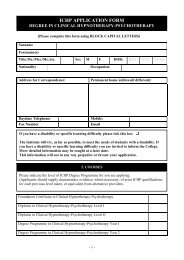EuroSDR Projects - Host Ireland
EuroSDR Projects - Host Ireland
EuroSDR Projects - Host Ireland
You also want an ePaper? Increase the reach of your titles
YUMPU automatically turns print PDFs into web optimized ePapers that Google loves.
optimize their parameters for each and every image, as constant parameters were seen as too<br />
challenging.<br />
4 Approaches and Evaluation of Results<br />
We have finally obtained for every data set at least one result. Results that could be evaluated have<br />
been sent in by six groups. We will shortly introduce the groups and their approaches (alphabetical<br />
ordering according to corresponding author given in bold). Details for some of the approaches can be<br />
found in Appendices 6 to 8. Selected results and their analysis are presented in (Mayer et al. 2006).<br />
The approaches of Bacher, Gerke, and Hedman are all three based on the work of TU München of<br />
Wiedemann and Hinz (1999) and partially Baumgartner et al. (1999a, 1999b). Hedman mostly<br />
optimizes the line extraction of the former for the data at hand by employing the blue channel as well<br />
as the NDVI. Opposed to this, Bacher and Gerke also make use of the work of Baumgartner et al.<br />
(1999a, 1999b). While Bacher has devised an approach automatically generating training data for a<br />
multispectral classification and employs snakes on the classification result to bridge gaps, Gerke uses<br />
the original approach of Wiedemann and Hinz (1999) with customized parameter settings (Gerke_W)<br />
as well as the original approach of Baumgartner et al. (1999a, 1999b) with the improved basic line<br />
detection of Wiedemann and Hinz (1999 – Gerke_WB).<br />
• Uwe Bacher, Institute for Photogrammetry and Cartography, Bundeswehr University Munich,<br />
Germany: The approach is only suitable for the Ikonos images. It is based on earlier work from TU<br />
München of Wiedemann and Hinz (1999) and partially Baumgartner et al. (1999a, 1999b). The<br />
approach of Wiedemann and Hinz (1999) starts with line extraction in all spectral bands using the<br />
sub-pixel precise Steger line extractor (Steger 1998) based on differential geometry and scalespace<br />
including a thorough analysis and linking of the topology at intersections. The lines are<br />
smoothed and split at high-curvature points. The resulting line segments are evaluated according to<br />
their width, length, curvature, etc. Lines from different channels or extracted with different scales,<br />
i.e., line widths, are then fused on a best first basis. From the remaining lines a graph is<br />
constructed, supplemented by hypotheses bridging gaps. After defining seed lines in the form of<br />
the most highly evaluated lines, optimal paths are computed in the graph and from it gaps to be<br />
closed are derived. Bacher has extended this by several means (Bacher and Mayer 2004, 2005).<br />
The central idea is to take into account the spectral information by means of a (fuzzy)<br />
classification approach based on fully automatically created training areas. For the latter parallel<br />
edges are extracted in the spirit of (Baumgartner et al. 1999a, 1999b) in a buffer around the lines<br />
and checked if the area in-between them is homogeneous. The information from the classification<br />
approach is used to evaluate the lines. Additionally, it is the image information when optimizing<br />
snakes to obtain a more geometrically precise, but also more reliable basis for bridging larger gaps<br />
in the network, which is another new feature of Bacher's approach.<br />
• Charles Beumier and Vinciane Lacroix, Signal and Image Center, Royal Military Academy,<br />
Brussels, Belgium (also see Appendix 6): Their approach for Ikonos images rests on the gradient<br />
line detector of Lacroix and Acheroy (1998) which assumes that the gradient vectors on both sides<br />
of a line are pointing in opposite directions. Bright lines are extracted from the green channel with<br />
a slight Gaussian smoothing employing non-maximum suppression. Lines are tracked limiting the<br />
direction difference until a minimum strength is reached. Lines are only kept if they are at least 30<br />
pixels long and are straight enough when checked via the square root of the inertial moment. For<br />
each of the line points the Normalized Difference Vegetation Index (NDVI) is computed from the<br />
red and the infrared channel and if it is below zero, the point is supposed to be vegetation and is<br />
rejected. Finally, the rest of the points are again tracked and checked to see if they are still long<br />
226


